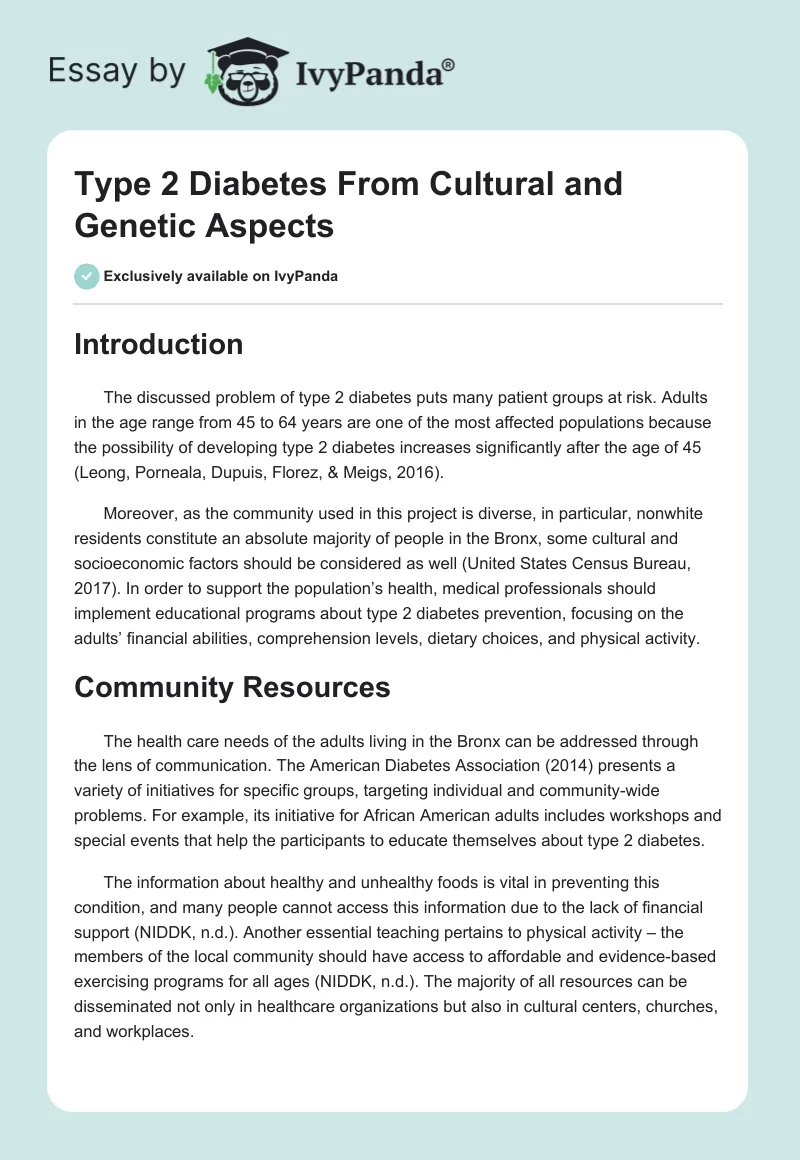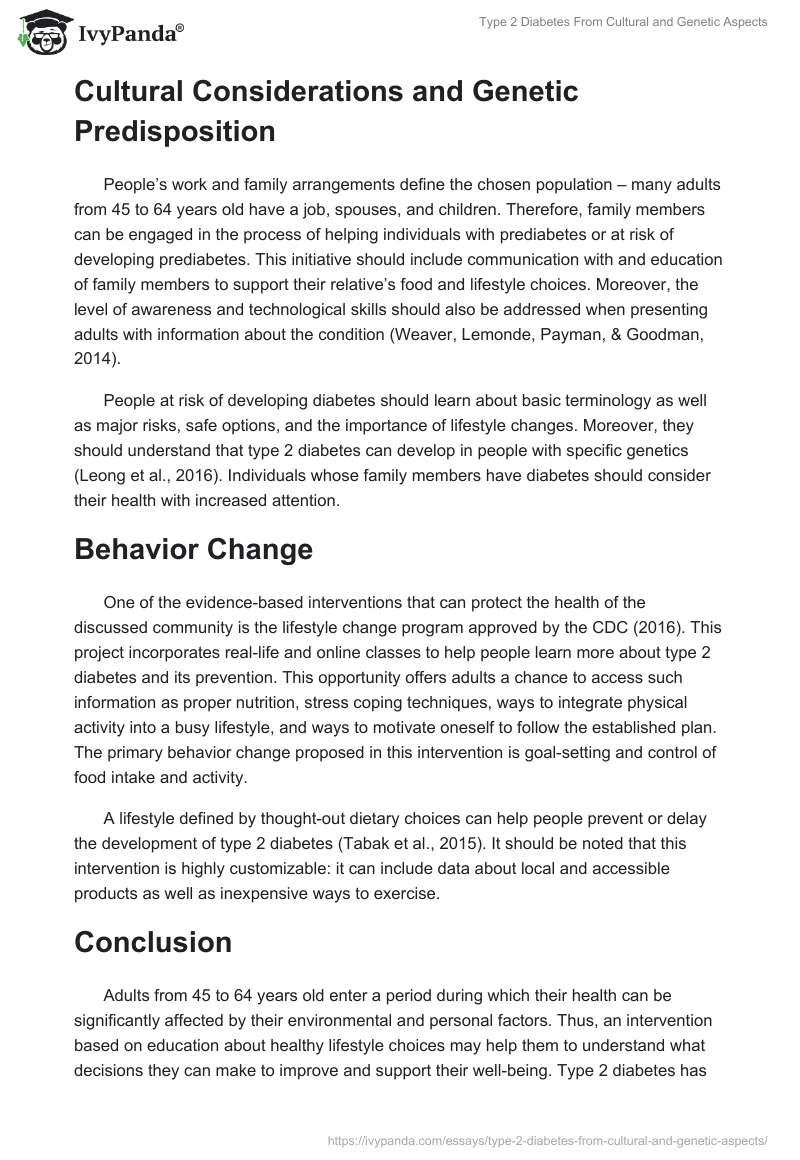Introduction
The discussed problem of type 2 diabetes puts many patient groups at risk. Adults in the age range from 45 to 64 years are one of the most affected populations because the possibility of developing type 2 diabetes increases significantly after the age of 45 (Leong, Porneala, Dupuis, Florez, & Meigs, 2016).
Moreover, as the community used in this project is diverse, in particular, nonwhite residents constitute an absolute majority of people in the Bronx, some cultural and socioeconomic factors should be considered as well (United States Census Bureau, 2017). In order to support the population’s health, medical professionals should implement educational programs about type 2 diabetes prevention, focusing on the adults’ financial abilities, comprehension levels, dietary choices, and physical activity.
Community Resources
The health care needs of the adults living in the Bronx can be addressed through the lens of communication. The American Diabetes Association (2014) presents a variety of initiatives for specific groups, targeting individual and community-wide problems. For example, its initiative for African American adults includes workshops and special events that help the participants to educate themselves about type 2 diabetes.
The information about healthy and unhealthy foods is vital in preventing this condition, and many people cannot access this information due to the lack of financial support (NIDDK, n.d.). Another essential teaching pertains to physical activity – the members of the local community should have access to affordable and evidence-based exercising programs for all ages (NIDDK, n.d.). The majority of all resources can be disseminated not only in healthcare organizations but also in cultural centers, churches, and workplaces.
Cultural Considerations and Genetic Predisposition
People’s work and family arrangements define the chosen population – many adults from 45 to 64 years old have a job, spouses, and children. Therefore, family members can be engaged in the process of helping individuals with prediabetes or at risk of developing prediabetes. This initiative should include communication with and education of family members to support their relative’s food and lifestyle choices. Moreover, the level of awareness and technological skills should also be addressed when presenting adults with information about the condition (Weaver, Lemonde, Payman, & Goodman, 2014).
People at risk of developing diabetes should learn about basic terminology as well as major risks, safe options, and the importance of lifestyle changes. Moreover, they should understand that type 2 diabetes can develop in people with specific genetics (Leong et al., 2016). Individuals whose family members have diabetes should consider their health with increased attention.
Behavior Change
One of the evidence-based interventions that can protect the health of the discussed community is the lifestyle change program approved by the CDC (2016). This project incorporates real-life and online classes to help people learn more about type 2 diabetes and its prevention. This opportunity offers adults a chance to access such information as proper nutrition, stress coping techniques, ways to integrate physical activity into a busy lifestyle, and ways to motivate oneself to follow the established plan. The primary behavior change proposed in this intervention is goal-setting and control of food intake and activity.
A lifestyle defined by thought-out dietary choices can help people prevent or delay the development of type 2 diabetes (Tabak et al., 2015). It should be noted that this intervention is highly customizable: it can include data about local and accessible products as well as inexpensive ways to exercise.
Conclusion
Adults from 45 to 64 years old enter a period during which their health can be significantly affected by their environmental and personal factors. Thus, an intervention based on education about healthy lifestyle choices may help them to understand what decisions they can make to improve and support their well-being. Type 2 diabetes has some genetic predispositions, but a person can delay the development of the disease with the support of medical professionals and loved ones. Such cultural considerations as family engagement, socioeconomic limitations, and awareness of the problem should be addressed.
References
American Diabetes Association. (2014). Live Empowered. Web.
Centers for Disease Control and Prevention (CDC). (2016). National diabetes prevention program: Lifestyle change program details. Web.
Leong, A., Porneala, B., Dupuis, J., Florez, J. C., & Meigs, J. B. (2016). Type 2 diabetes genetic predisposition, obesity, and all-cause mortality risk in the US: A multiethnic analysis. Diabetes Care, 39(4), 539-546.
National Institute of Diabetes and Digestive and Kidney Diseases (NIDDK). (n.d.). Support your patients with resources and referrals. Web.
Tabak, R. G., Sinclair, K. A., Baumann, A. A., Racette, S. B., Sebert Kuhlmann, A., Johnson-Jennings, M. D., & Brownson, R. C. (2015). A review of diabetes prevention program translations: Use of cultural adaptation and implementation research. Translational Behavioral Medicine, 5(4), 401-414.
United States Census Bureau. (2017). QuickFacts: Bronx County (Bronx Borough), New York. Web.
Weaver, R. R., Lemonde, M., Payman, N., & Goodman, W. M. (2014). Health capabilities and diabetes self-management: The impact of economic, social, and cultural resources. Social Science & Medicine, 102, 58-68.


